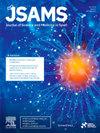The effect of training distribution, duration, and volume on VO2max and performance in trained cyclists: A systematic review, multilevel meta-analysis, and multivariate meta-regression
IF 3
2区 医学
Q1 SPORT SCIENCES
引用次数: 0
Abstract
Objective
This study aimed to systematically investigate whether polarized or non-polarized training leads to greater physiological and performance adaptations in cyclists.
Design
A systematic review and meta-analysis were conducted, focusing on interventions categorized as polarized, non-polarized, or unclear. Inclusion criteria required participants to be at least recreationally trained cyclists (VO2max ≥ 59 ml/kg/min) and interventions lasting > 4 weeks.
Methods
A multi-level random-effects meta-analysis using restricted maximum likelihood estimation was performed. A multivariate meta-regression assessed associations between training volume, VO2max, and time-trial performance.
Results
Forty-one studies, comprising 81 training groups and 797 participants, were included. Training significantly improved VO2max across all groups (g = 0.42, 95 % confidence interval = 0.31–0.53, P ≤ 0.001) and time-trial performance (g = 0.39, 95 % confidence interval = 0.25–0.53, P ≤ 0.001), with no significant differences between training modalities (P > 0.05). Longer intervention durations positively influenced VO2max (g = 0.03, 95 % confidence interval = 0.02–0.05, P < 0.001) and time-trial performance (g = 0.04, 95 % confidence interval = 0.03–0.06, P < 0.001). No associations were found between weekly or total training volume and changes in VO2max or time-trial performance.
Conclusions
Polarized and non-polarized training modalities yield comparable improvements in VO2max and time-trial performance in trained cyclists. Beyond achieving a necessary training volume, further increases do not appear to enhance performance. These findings encourage athletes and coaches to prioritize effective training distribution rather than fixating on total volume or a specific model
训练分布、持续时间和训练量对自行车运动员最大摄氧量和运动表现的影响:一项系统综述、多水平荟萃分析和多元荟萃回归。
目的:本研究旨在系统地调查极化或非极化训练是否会导致自行车运动员更大的生理和性能适应。设计:进行了系统回顾和荟萃分析,重点关注极化、非极化或不明确的干预措施。纳入标准要求参与者至少是娱乐性训练的骑自行车者(VO2max≥ 59 ml/kg/min),干预持续> 4周。方法:采用限制性最大似然估计进行多层级随机效应meta分析。多元元回归评估了训练量、最大摄氧量和计时赛成绩之间的关系。结果:纳入41项研究,包括81个训练组和797名参与者。训练显著提高心肺功能在所有组(0.42 g = ,95 %置信区间 = 0.31 - -0.53,P ≤0.001 )和计时赛性能(g = 0.39,95 %置信区间 = 0.25 - -0.53,P ≤0.001 ),培训模式之间无显著差异(P > 0.05)。较长的干预持续时间正影响VO2max (g = 0.03,95 %置信区间 = 0.02-0.05,P 2max或赛时表现。结论:极化和非极化训练方式对训练自行车运动员的最大摄氧量和计时赛成绩有相当的改善。除了达到必要的训练量之外,进一步增加训练量似乎并不能提高成绩。这些发现鼓励运动员和教练优先考虑有效的训练分配,而不是专注于总量或特定模式。
本文章由计算机程序翻译,如有差异,请以英文原文为准。
求助全文
约1分钟内获得全文
求助全文
来源期刊
CiteScore
7.40
自引率
10.00%
发文量
198
审稿时长
48 days
期刊介绍:
The Journal of Science and Medicine in Sport is the official journal of Sports Medicine Australia (SMA) and is an an international refereed research publication covering all aspects of sport science and medicine.
The Journal considers for publication Original research and Review papers in the sub-disciplines relating generally to the broad sports medicine and sports science fields: sports medicine, sports injury (including injury epidemiology and injury prevention), physiotherapy, podiatry, physical activity and health, sports science, biomechanics, exercise physiology, motor control and learning, sport and exercise psychology, sports nutrition, public health (as relevant to sport and exercise), and rehabilitation and injury management. Manuscripts with an interdisciplinary perspective with specific applications to sport and exercise and its interaction with health will also be considered.

 求助内容:
求助内容: 应助结果提醒方式:
应助结果提醒方式:


